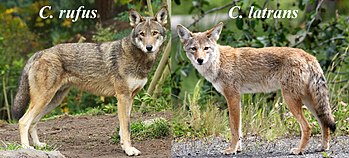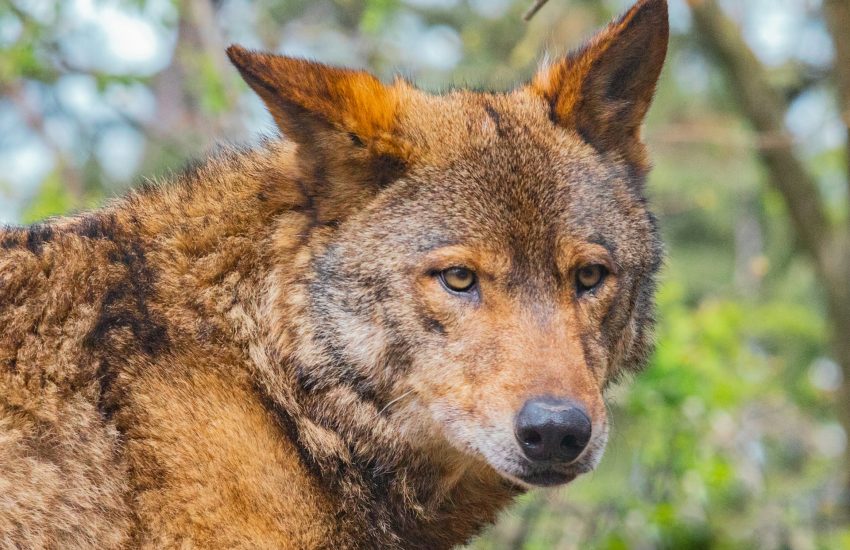Historically the red wolf (Canis rufus) ranged from southeastern Texas to central Pennsylvania. It is native to the southeastern United States. Today, the only place red wolves can be found in the wild is in eastern North Carolina’s Albemarle Peninsula.
Red wolves are highly adaptable and can live in a variety of habitats: forested areas, grasslands, steppes, tundra, boreal forests, and even deserts. They can survive in both cold and hot climates. However, like all other wolves, they prefer mountainous areas and prairies (steppe) over swamps. The best habitat for wolves depends, of course, on the availability of prey and the absence of human threats.
The red wolf was nearly driven to extinction by the mid-1900s in part due to predator-control programs and habitat destruction, but mostly by hybridization with coyotes. In 1980, red wolves were declared extinct in the wild by the United States Fish and Wildlife Service (USFWS).
U.S. Fish & Wildlife Service captured the 14 remaining red wolves they could find in the wild. These wolves are the ancestors of the red wolves that now live in the wild in North Carolina. By 1987, enough red wolves had been bred in captivity to attempt a restoration program to return the species to a portion of their original range in the Southeast United States.
The current population of red wolves in eastern North Carolina is estimated to be between 15 and 17 in their native habitat. However, only 10 wolves are collared and tracked. These numbers may vary due to factors such as births, deaths, migration, and tracking effort.
Over the past 30 years, coyotes have moved into the habitat range formerly occupied by the red wolf and now compete with the reintroduced wolves for resources. Though the smaller coyotes do not pose a direct challenge to red wolf territory, any potential offspring between coyotes and red wolves endangers the red wolf’s long-term viability as a unique species.

Red Wolf
Coyote
Traffic signs put up on Highway 64 in Dare County say
“ENDANGERED RED WOLF CROSSING. DRIVE WITH CAUTION.”
This obviously insinuates that cars and traffic are what endangers red wolves. Well, they do, but they are by far not the most serious threat to the survival of the red wolf. The most serious threat to the survival of the red wolf is hybridization with coyotes.
Hybridization occurs when red wolves and coyotes mate. When a red wolf cannot locate a red wolf mate it will accept a coyote and produce hybrids.
Since USFWS cannot control the mating behavior of red wolves or coyotes in the wild, apparently, efforts have been made to sterilize coyotes or even to kill the hybrid offspring.
In northeastern North Carolina, red wolves roam 1.7 million acres in five counties: Dare, Hyde, Tyrrell, Washington, and Beaufort. They include three national wildlife refuges, a U.S. Air Force bombing range, and private land. The red wolf recovery program is unique in that more than half of the land used for reintroduction lies on private property. Approximately 680,000 acres are federal and state lands, and 1,002,000 acres are private lands.
The exact number of species that have existed and disappeared over Earth’s history is difficult to determine with precision but it has been estimated that of all the species that have existed on earth at some point over the past 3.5 billion years, over 95% have gone extinct. This amounts to over five billion species. It is important to note that these are estimates. Many species have likely gone extinct without leaving any trace.
As species become extinct, new species are continuously developing on Earth. This process is known as ‘speciation’. It occurs when a group of individuals separate from their species for a long span of time and later evolve as a different trait. Other factors may also contribute to the development of new species such as isolation, genetic drift, mutations, the so-called ‘founder effect’, and migration.
Speciation is a slow process that often takes thousands to millions of years. Therefore, while we can observe the early stages of speciation in some populations today, it is impossible to observe the complete process within a human lifespan.
The number of species existing on Earth today has been estimated to be between 2 million and 1 trillion. But most estimates suggest that there are around 11 million species or fewer. Again, these are estimates, and the actual number might be higher or lower. Also, we have identified only a small fraction of the world’s species, so numbers may vary widely. As of 2021, the IUCN Red List listed 2.13 million species on planet Earth.
Efforts to preserve the red wolf as a separate species have now been going on for several decades. So far, to my best knowledge, several million dollars have been spent on various red wolf projects with dismal results.
The exact total amount of money spent on the preservation of the red wolf as a species is not readily available. I have heard that already about 30 million dollars have been spent on the red wolf program. Not sure if this is true. However, various organizations and initiatives have contributed significant funds towards this cause. For instance, at least $575,000 have been pledged towards an overall goal of $5 million for the construction of the American Red Wolf Conservation and Research Center (ARWCRC) at Craighead Forest Park in Jonesboro. The U.S. Fish & Wildlife Service’s Red Wolf Recovery Program and the National Wildlife Federation’s support of red wolf recovery efforts in North Carolina likely involve substantial funding, but specific figures are not provided. According to a recent article by Wolf.org, the updated Red Wolf Recovery Program calls for a budget of $328 million over the next 50 years. That’s $6.6 million per year. It is a safe assumption that most or all of this money is tax money.
There is another strange angle to the red wolf drama. It is commonly known that Tyrrell County and Washington County are prone to flooding. The main cause of this is not, as we are told, the beavers. The main cause is that, for over 25 years now, the canals and trenches in these counties have not been properly maintained. It’s obvious. Anyone who drives through these counties can see it. The result is that in the event of major precipitation the water cannot run off properly into the sounds. In discussions with U.S. Fish & Wildlife Service representatives I was advised that it makes no sense to maintain the trenches in these counties because the entire area will soon be inundated anyway due to rising ocean levels because of global warming.
Assuming that this is true, why then is the U.S. Fish & Wildlife Service trying to re-introduce red wolves into an area that, according to their own prognosis, will soon be under water? Surely, red wolves will not grow webs between their toes and become amphibious. If we are all washed out of our habitats, so will the red wolves.
One has to wonder why we are going to such length and significant expense to resurrect a species that has already gone extinct, that cannot preserve itself in the presence of coyotes, and that will be driven away again by the rising ocean waters.
Are we all nuts?
